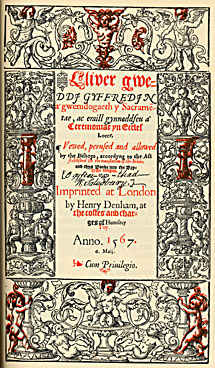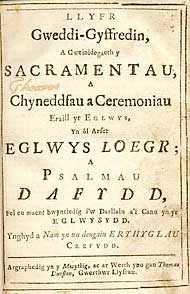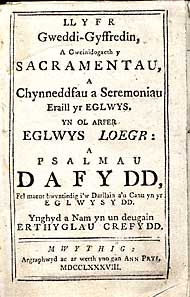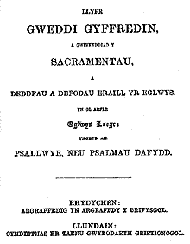CHAPTER VII
RICHARD DAVIES AND THE WELSH TRANSLATIONS
THE Welsh or Cymric is the most important living representative of the British branch of the Celtic family of languages. It is spoken by about a million people, and has a considerable literature.
An Act of Parliament passed in the year 1563 (5 Eliz. c. 28), entitled “An
Act for the Translating of the Bible and the Divine Service into the
Welsh Tongue,” ordered that the Old and New Testament, together
with the Book of Common Prayer, were to be translated into Welsh, the
work to be edited by the four Welsh bishops, viz., of St. Asaph, Bangor,
St. David’s and Llandaff, and the bishop of Hereford, then largely
a Welsh diocese. The translations were to be ready for use on March 1,
1566. The Prayer Book in Welsh appeared in 1567. It was the work of Richard
Davies, bishop of St. David’s, and William Salessbury (?), joint
translators also of the New Testament into Welsh. The title of this first
Welsh Prayer Book was: Lliver gweddi gyffredin a’gwenidogaeth y
Sacramentae, ac eraill gynneddfeu a’Ceremoniae yn Eccles Loeer
Psallwyr neu Psalmae David. Colophon: Imprinted at London, by Henry Denham,
at the costes and charges of Humfrey Toy[1] 1567 ....

Griffiths 192:2; reprinted in 1965 (192:73)
Black letter. Folio. Page, 5-15/16 x 9¼;
paper, 7¼- x 11-5/16 inches. Initial ornamental letters. Title and preliminary
matter, 18 leaves; text, 143 leaves, ending on signature & 7
b, with
the colophon. Signatures: ¶ in 8, ![]() in
10, A in 4, B — Z, in sixes, & numbering
8 leaves. The Psalter, with separate title, numbers 84 leaves, signatures
A — O in sixes. The whole volume numbers 245 leaves = 490 pages. According
to Ballinger, The Bible in Wales (London, 1906), Part I, p.
17, and Part II, p. 4, only three copies of this editio princeps are
recorded — one in the Swansea Public Library, one with Sir John Williams,
Bart., and one in private hands. Each copy lacks the title-page. The
title, as given above, is quoted from Rowlands Cambrian
Bibliography.
It is not impossible that there still existed a copy with title-page
at the time when Rowlands compiled his bibliography. According to Darlow
and Moule, Vol. II, Part iii, p. 1659, a fourth copy, also without title-leaf,
is in the National Library of Wales. (Griffiths records copies at the
Cardiff & Swansea Public Libraries, and at Manchester Univ.)
in
10, A in 4, B — Z, in sixes, & numbering
8 leaves. The Psalter, with separate title, numbers 84 leaves, signatures
A — O in sixes. The whole volume numbers 245 leaves = 490 pages. According
to Ballinger, The Bible in Wales (London, 1906), Part I, p.
17, and Part II, p. 4, only three copies of this editio princeps are
recorded — one in the Swansea Public Library, one with Sir John Williams,
Bart., and one in private hands. Each copy lacks the title-page. The
title, as given above, is quoted from Rowlands Cambrian
Bibliography.
It is not impossible that there still existed a copy with title-page
at the time when Rowlands compiled his bibliography. According to Darlow
and Moule, Vol. II, Part iii, p. 1659, a fourth copy, also without title-leaf,
is in the National Library of Wales. (Griffiths records copies at the
Cardiff & Swansea Public Libraries, and at Manchester Univ.)
This Prayer Book contains the earliest edition of the Psalter in Welsh. The fact that the version of the Liturgical Epistles and Gospels here given differs not only from the translation by William Salesbury in his Ilith a Ban of 1551, but also from that of the 1567 New Testament, suggests that Bishop Davies, while co-operating with Salesbury in the New Testament, followed a plan of his own in translating the Prayer Book. The use of some words was called in question, and in the second edition (1586) appears:
“An explanation of certaine wordes, being quarrelled withall by some, for that in this translation they be otherwise written, then either the unlettered people or some parts of the countrie sounde. or speake them.”
Richard Davies was born in 1501, and died in 1581. He was educated at New Inn Hall, Oxford. He always was a decided reformer and was obliged during the reign of Queen Mary to flee from Wales to Frankfort, Germany, and thence to Geneva, Switzerland. In Frankfort he belonged to the party in the English church which desired to conform in their worship with the liturgy of the Book of Common Prayer. On the accession of Elizabeth he returned to England and received back the preferments which he had enjoyed under Edward VI. In 1560 he was consecrated bishop of St. Asaph. The year following he was translated to the bishopric of St. David’s. In January, 1562, he was present at the Convocation which drew up the Thirty-nine Articles. He signed the canons of 1571, and joined the majority of the bishops in petitioning the queen, in 1566, to offer no impediment to the Articles Bill. In his homeland, Wales, he was a very influential and important person; active in the administration and reformation of his diocese; the trusted adviser of Archbishop Parker and Cecil on Welsh affairs, and the ardent advocate of all schemes for the intellectual and religious enlightenment of his countrymen. Davies set himself energetically to work to provide a vernacular theological literature for his country. He enlisted the co-operation of his neighbour in the Vale of Conway, William Salesbury, to whose almost single-handed efforts had been already due the first books ever printed in Welsh. It is impossible at this late period to determine the respective share of the two men in the translation of the Prayer Book.
William Sale(i)sbury (1520?-1600?) was educated at Oxford, 1540-47,
where, also, he was converted to Protestantism by Jewel, the leader of
the Protestant party of the university. His main work was along the lines
of Welsh philology and lexicography. The passage of the Act of 1563,
mentioned above, is doubtless due mainly to the efforts of Salesbury.
To him, also, the bishops entrusted the work required in this Act. The
Prayer Book and the Psalms were published a short time before the New
Testament.
[1] Henry Denham was printer in. London from 1560-89. He had been one of Richard Tottell’s († 1593) apprentices, and took up his freedom in the Company of Stationers on August 30th, 1560. He printed many books and had a large and varied assortment of type, his blacks being noticeable for their clearness and beauty, while his nonpareil and other small type are remarkable for their regularity. He had a large assortment of initial letters, ornaments and borders, many of which were extremely attractive. About 1574 he acquired the patent of William Seres for printing the Psalter, the Primer for Little Children, and all books of private prayer in Latin and English. The extent of his business is shown by the fact that in 1583 he was returned as having four presses. He used two devices, the earlier consisting of a simple star, the later a star surrounded by a heavy frame in which the arms of the City of London and of the Company of Stationers were incorporated.
Humphrey Toy was a bookseller in London, 1560-77. He
was the son of Robert Toy(e), printer (1542-56) and matriculated as a
sizar of Queen’s
College, Cambridge, in November, 1551. He took up his freedom in the
Company of Stationers on March 11th, 1557/8. and set up in business at
the sign of the Helmet. He served ·the office of underwarden in
the year 1571-72, and died on October 16th, 1577.
A second edition was issued in 1586, entitled,
Lliver Gweddi Gyffredin, a Gweinidogaeth y Sacramentae, ac eraill Gynneddfau
a Ceremoniae yr Eccles Loecr; Vewed, perused and allowed by the Bishops,
according to the act stablished for the translation of the Bible and
this Book into the British tongue. The final colophon reads: At
London imprinted by John VVindet, at the costes and charges of Thomas
Chard[2], 1586 .... Black letter. It is an almost exact reprint
of that of 1567. A minute description of this second edition is given
in Rowlands, Cambrian Bibliography, 1869, pp. 31-39.
Griffiths 192:3
Griffiths 192:4
A revised translation was put out in 1621 by Bonham Norton and John Bill. According to Rowlands, p. 102, the title begins: Llyfr y Weddi Gyffredin, etc., 4to. Black letter. Sig. A, B, A — U, Aa — Mm. This edition contained, for the first time, the new metrical rendering of the Psalms, by Edmund Prys. It is entitled, Llyfr y Psalmau. Wedi ev cyfieithv, a’i cyfansoddi ar Fesvr Cerdd yn Gymraec. Drwy waith Edmwnd Prys, Archdiacon Meirionnydd ... A’i Printio yn Llvndain, 1621. This edition was reprinted by Robert Barker in 1630, 8vo; and by the assigns of John Bill in 1634, 4to. In the 1621 edition the Epistles, Gospels and Psalms are taken from Bishop Parry’s Bible (1620), which is now recognised as the’ Welsh authorized version. The Prayer Book is supposed to have been edited by Bishop Parry and Dr. John Davies.
Title in alternately black and red type. Black letter. Small 4to. The Psalms have a separate title. The volume contains also “Llyfr y Psalmau, ... ar fesvr cerdd, ... drwy waith Edmund Prys. | A’i Printio, Yn Llundain, 1638. Copy in the J. P. Morgan library.
Edmund Prys (1541 ?-1624), rector of Festiniog and archdeacon of Merioneth, was a skilful composer in the strict Welsh metres, and took an active part in the bardic life of his time. His great reputation rests on his beautiful translation of the Psalms into free Welsh verse, suitable for congregational singing. The translation appeared first in 1621 as an appendix to the new issue of the Welsh Prayer Book. He deliberately rejected the bardic metres, in which he was a finished writer, in order to adapt his work for popular use. His verses, in consequence, acquired a popularity which has not yet vanished. Many of the Psalms are still sung in Welsh places of worship.
A new revision — probably by Bishop George Griffith (1601-1666), of St. Asaph (1662-1666) — and based on the revised English book of 1662, was published in 1664, entitled, Llyfr | Gweddi | Gyffredin, | a | Gweinidogaeth y Sacramentau, | a Chynneddfau a Ceremoniau ereill yr | Eglwys, yn ol arfer Eglwys Loegr, | ynghyd a’r Psallwyr neu Psalmau | Dafydd. || A Printiwyd yn Llundain, | gan S. Dover, tros Edward Ffowks, | a Pheter Bodwel. MDCLXIV Folio. Black letter. Title in compartment, with royal arms on top. This title measures 5¾ x 9⅜ inches. Page, 5 x 9¾; paper, 7 x 10¾ inches. Printed in long lines, with many initial wood-cut letters. Title, reverse blank; table of contents, one leaf (reverse blank). Introductory matter, sig. a — n, in twos; text, A — Z, Aa — Zz, Aaa — Zzz, Aaaa — Cccc, in fours; Dddd, two leaves. Copy in the J. P. Morgan library. Later editions, London, Bill, 1678, 8vo, and Oxford, 1683, 8vo.
The revision of 1664 is considered as of high authority, having been made
under the 27th clause of the Act of Uniiformity of Charles II.
Griffiths 192:5 (1621)
Griffiths 192:6 (1630)
Grifftihs 192:7 (1634)
[2] John Windet was a printer in London from 1584-1611. He set up in business at the White Bear in Addling Street, “nigh Baynard’s Castle.” His business increased rapidly, and in 1586 he had three presses. In 1603 he succeeded John Wolf as official printer to the City of London. He continued in business until 16II when he assigned his copyright to William Stansby, who ultimately succeeded to the business. His elegant device, adopted .from Richard Jugge (t 1577), consisted of a massive architectural panel, adorned with wreaths of fruit, bearing in the centre an oval surrounded by various mottoes and enclosing a pelican feeding her young. On the left of the oval stands a female figure having a serpent twined round her right arm, with the word Prudentia underneath; while a second female figure, to the right, with balance and sword, is called Justicia. In the bottom centre is a small cartouche panel, with the name J. vVindet in the form of a mouogram.
Thomas Chard or Chare was a bookseller in London. 1577-1618. He is entered as the son of Thomas Chare of Dartforth. Kent. apprentice to Humphrey Toy for ten years from Christmas 1565 on. and appears to have succeeded to his business on Toy’s death in 1577. Among his publications was an edition of Bishop Jewel’s Apologia ecclesiæ Anglicanæ in the Welsh tongue, a Prymer in Welsh and the Welsh translation of the Book of Common Prayer. Most of his other publications were likewise of theological character. He died about 1622. The majority of his books were issued without indication of his place of business.
Griffiths 192:8 (1664); 192:9 (1678); 192:10 (1683)
A fresh translation was edited by Ellis Wynne (1671-1734) in (1709) 1710, and published by Powell in London. The title of a 1743 edition of this new translation reads as follows:
* Llyfr | Gweddi-Gyffredin, | a Gweinidogaeth y Sacramentau, | a | Chyneddfau a Ceremoniau eraill yr Eglwys, | yn ôl Arfer | Eglwys Loegr; a | Psalmau | Dafydd, | fel eu maent bwyntiedig i’w Darllain a’i Canu yn yr | Eglwysydd. | Ynghyd a nam yn un deugain Erthyglau | Crefydd. | Argraphedig yn y Mwythig, ac ar Werth yno gan Thomas | Durston, Gwerthwr Llyfrau, 1743.
The Book of Common Prayer is followed by: Cydymmaith i’r Allor
.. | Yn dangos | Natur ac Angenrheidrwydd | o | Ymbarattoi i’r
Sacrament, | mewn trefn | ni dderbyn yn deilwng | y Cymmun Sanctaidd.
| . . . | At yr hyn y chwanegwyd, | Gweddiau a Myfyrdodau, | Ymbar- |
attôi
i dderbyn y Sacrament, fel ag y mae Eglwys | Loegr yn gofyn gan ei Chymmunwyr·||
. . . | Argraphwyd yn y Mwythig, ac ar werth yno gan | Thomas Durston,
I738. A Welsh translation of Vicars (Vickers), a Companion to the Altar,
etc. This, again, is followed by Llyfr y Psalmau, | ... Drwy waith Edmund
Prys. Three pages of hymns are added to the edition of the Psalms. Psalms
and hymns are printed in double columns. Page, 3⅛ x 5⅜; paper, 4 x 6
inches. The Prayer Book has sigs. A — Z, Aa — Ff in eights, Gg, six leaves.
Almanack, 1743-70, on sig. C 1, obverse. The Companion to the Altar numbers
(2), 54 pages, and the Psalms sig. A — H in fours.
Griffiths 192:14 (1709); 192:15 (1710); 192:24 (1733); 192:25 (1743) & many others

Griffiths 192:24 (printed by T. Dunstan in Shrewsbury, 1733)
A few years prior to this edition John Baskett published for the S.P.C.K. * Llyfr Gweddi Gyffredin, a Gweinidogaeth y Sacramentau, ... Yn Rhydychen, dros Joan Basged. MDCCXXVII. (80) pages. Page, 3⅝ x 6¼; paper, 4¼ x 7⅛ inches. Printed in double columns and red-lined throughout. The Prayer Book is followed by the Apocrypha of the Old Testament and the New Testament, the translation having been corrected by the Rev. Moses Williams (1686-1742), vicar of Devynnock; the Psalms in metre by Edmund Prys, and hymns. A companion volume contains the Welsh translation of the Old Testament, likewise edited by Moses Williams.
(At right) Welsh Prayer Book printed by Ann Prys in Shrewsbury, 1788 (Griffiths 192:36)
Grifftihs 192:22

Griffiths 192:65
Griffiths 192:66 (1880)
Griffiths 192:68 (1889)
The first English-Welsh edition of the Liturgy was pubblished in 1823, Clwydian Press: Denbigh, Thomas Gee. The two languages are printed in parallel columns, the English occupying the left and the Welsh the right column. Page, 4⅛ x 7; paper, 5¾ x 9¼ inches. At the end of the volume are four pages of notes, followed by another four pages containing a list of subscribers. Another edition appeared the same year from the University Press, Oxford. This was reprinted in 1840, 1854 and 1859, 620 pages, 8vo.[3]
[3] In 1844 the General Convention of the Protestant Episcopal Church in the United States appointed a committee for a Welsh translation of the Prayer Book, consisting of William Heathcote Delancey (1797-1865), first bishop of Western New York (1839-1865); William Rollinson ¥hittingham (1805-1879). bishop of Maryland (1840-1879), and Stephen Elliott (1806-1866). then first bishop of Georgia (1841-1844). The committee was discharged in 1847. Three years later a new committee of the House of Clerical and Lay Delegates was appointed, and discharged in 1853, the committee rendering an adverse report. Nothing further has been done toward a Welsh translation of the American Prayer Book. See Journal of ... General Convention. 1844, pp. 95, 99. 166, 175 ; 1847, p. 151; 1853. p. 144.
A good narrative of the” Welsh Version of the Prayer Book,” by J. Fisher, is printed on pp. 820-822 of The Prayer Book Dictionary. 1912.
Griffiths 192:47; 192:51 (1837, 1838, 1840); 192:58 (1850, etc.); 192:67 (1889-1938)
CHAPTER VIII
BISHOP PHILLIPS AND THE TRANSLATIONS INTO MANX
THE Manx dialect, spoken only on the small
Isle of Man and now almost extinct, belongs to the Gaelic. branch of
the Celtic family of languages, and is closely related to the Gaelic
of the Scottish highlands. It was reduced to writing during the reign
of James I by men ignorant of Gaelic literature or of the principles
of Gaelic orthography. Thus, as seen in a printed book, it looks much
less like the Irish, either of the Highlands or of the natives of Ireland,
than it really sounds when spoken.
Griffiths 105:1
Griffiths
105:10 (1610 & 1765 in parallel columns)
Vol. I (xxiv, 466 pages) contains: Biographical Memoir of Bishop Phillips, Description of the MS., and Texts and Rubrics to the end of the Commination Service. Vol. II (pp. (3), 467-670; xiv, 183 (1)) contains: The Psalms, and Appendices, followed by “The Outlines of the Phonology of Manx Gaelic,” by John Rhŷs . . ..
The two volumes are excellently printed, and constitute a splendid testimonial to the scholarship of Bishop Phillips. Mr. Moore, who describes the spelling as phonetic and the translation as “simple and direct,” says that it is “for the most part easily understood by those who speak Manx at the present day.”
The main editor, Arthur William Moore, was born in 1853. He is Speaker of the House of Keys, a Manxman by birth, education and literary profession. He is one of the very few living students of Manx language and literature, history and folk-lore, and has written many contributions in his chosen field of literary activity.
In the year 1763 the S.P.C.K. gave out proposals for printing Bibles,
Common Prayer Books, &c., in the vulgar tongue of the Isle of Man.
By the encouragement they met with they were enabled to print, and disperse
gratis an edition of 1,500 copies in 8vo, and fifty copies, printed in
4to, for the use of the churches and for presents. The book was printed
in London by J. and W. Oliver, Printers to the Society for Promoting
Christian Knowledge, in Bartholomew Close, near West Smithfield. MDCCLXV.
Not paged from A to CCC.
This translation, which is now called “The New Version,” in contrast to that of Bishop Phillips, is due to the efforts of Bishop Hildesley. Mark Hildesley (1698-1772) became bishop of Sodor and Man in 1755. Although an Englishman by birth, he devoted all his energies to provide his Manx flock with a complete version of the Holy Scriptures and the Book of Common Prayer. He learned Manx sufficiently well to conduct the services of the church in that language, but he never acquired it perfectly. With the sanction and support of the S.P.C.K., which liberally encouraged the enterprise, he printed the New Testament and the Book of Common Prayer, translated by the clergy of the diocese. Later on followed the version of the Old Testament.
This Manx Prayer Book contains no prayer for the High Court of Parliament
of Great Britain and Ireland; but, instead of it, there is a prayer for
the members of the House of Keys, together with a prayer for the Lord
and Lady of the Isle, as clauses in the Litany, and in the prayer for
the Royal family, viz.: “And with them the Lord and Lady, and Rulers
of this Isle.”
Griffiths 105:4
At the suggestion of Claudius Crigan, bishop of Sodor and Man (1784- † 1813), the same society undertook, in 1808, and caused to be printed by John Ware, at Whitehaven, a *fourth edition of the Liturgy in Manx to the extent of 5,000 copies, which were distributed at a charge to the natives of little more than one-third cost price. The introductory matter in this edition, on sig. A, 6 leaves, and b 4, is in English. The text follows on sig. B — Z, Aa — Ii, in sixes, Kk and Ll, 2 leaves each. Follows a selection of the Psalms, 20 pages. The headings, directions and rubrics in this edition, as in its predecessors, are all in English. Page, 3⅜ x 5¾; paper, 4 x 6½ inches. Two columns to the page.
In 1825 Dr. George Murray (1784-1860), bishop of Sodor and Man (1814-1827),
informed the S.P.C.K. that the displacement of Manx by English on the
island had removed the necessity of providing further copies of the Manx
Bible and Liturgy.
Griffiths 105:7
